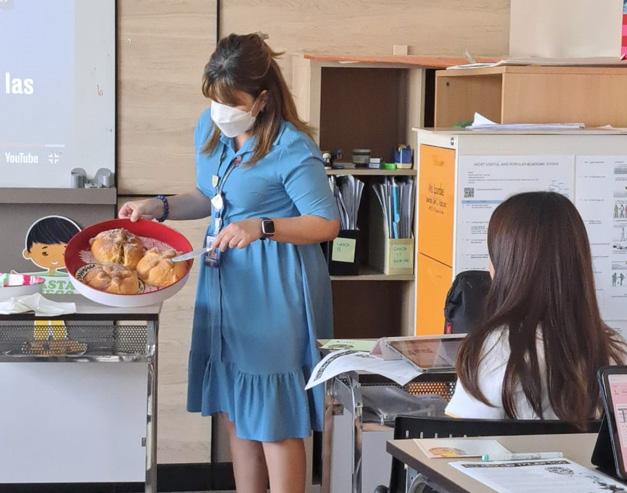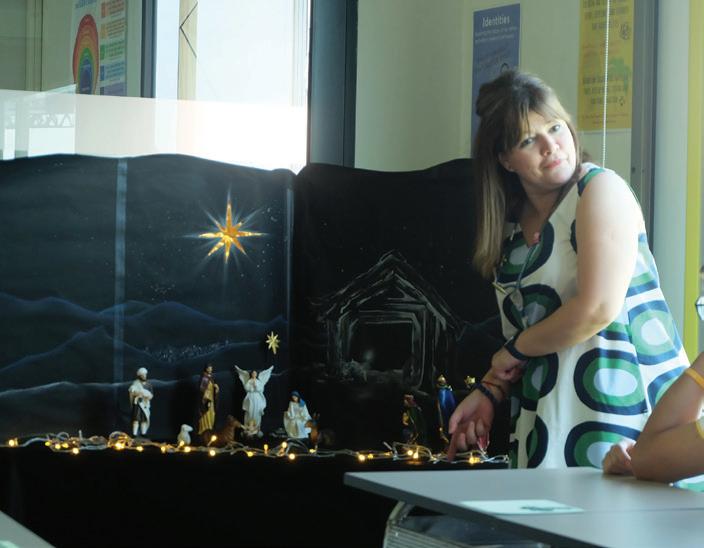
Greetings from




November marks the start of some festivals and celebrations around the world in Hispanic countries, and a fantastic opportunity to learn some facts about one of the most emblematic, rich in culture, and famous in Mexico and regions of Central America : El Dia de los Muertos or Day of the Dead.
Celebrated every November 2nd, when all souls of the dead are believed to return to the world of the living, people honor their loved ones by bringing flowers to their graves; most of the time they stay overnight bringing candles and marigold flowers or “cempasuchiles”, as they typically call them. Meanwhile, at their homes, altars are often created by two levels and the “ofrendas” are composed of four elements that represent earth, water, air and fire. Moreover, people decorate their altars with photos of the deceased family members with their favorite food and drinks.
There is one delicious tradition Ms. Lou introduced as part of her class for the Grade 11 class: El Pan de Muerto or Bread of the Dead. This culinary dish represents the cycle of life and death.It is decorated with a sugar coating that represents the tears shed by the family members, a reminder of love; it is also believed to be a sweet treat to enjoy during the afterlife. A cross and a small ball at the center symbolizes the bones and skulls of the departed; the orange flavor used in the bread symbolizes the journey to the underworld; however, this may vary based on the region or background.
To conclude, the students learned some facts about the Day of the Dead, and how this can be similar or different from their own culture. Apart from “catrinas”, “calaveritas”,” cempasuchiles”, and “atol” among others, el Pan de Muerto is history, culture and also a sweet key of the vibrant Mexican tradition of celebrating life and to honor a mother, father, sister, son or daughter that will always live in our hearts.
December continues with some religious and cultural celebrations: In some hispanic countries with Mother’s Day, and the famous “Posadas” that are the prelude to decorate the houses with “El Belen” or the Nativity Scene. Most of the population of the world know when and how Christmas is celebrated; but El Belen is an essential tradition since it represents the birth of Jesus Christ and one of the symbols of La Navidad. The main elements are: the Star that guided the Wise Men from the East symbolizes faith; the manger represents the possible place where Jesus was born and is the central figure, along with His parents, Mary and Joseph; a mule and an ox are laid down behind the

family; the family itself is a symbol of fidelity, strength and obedience. The shepherds are also important because it is believed that they were first instructed by an angel who announced that a Baby was born in Bethlehem. Then, they found the manger, bringing important presents for the Baby: a lamb, cottage cheese and almonds. Finally the Three Wise Men are also important, but according to tradition, some historians have stated they arrived on January 6th (that is also a big celebration in Spain, Mexico and Panama) and this explains why they are placed not too close to the manger. Melchor, Gaspar and Balthasar are important since they represent all the people around the world despite race, ethnicity or religion, according to Christian tradition. More figures have been added from the XV Century, a tradition that was brought to Spain by St Fancis of Assisi. As a Hispanic teacher, I proudly wanted to bring just a piece of our beliefs, from 21 countries around the globe to this beautiful country. Do you have any similar celebrations in your continent? ¡Hasta pronto!
